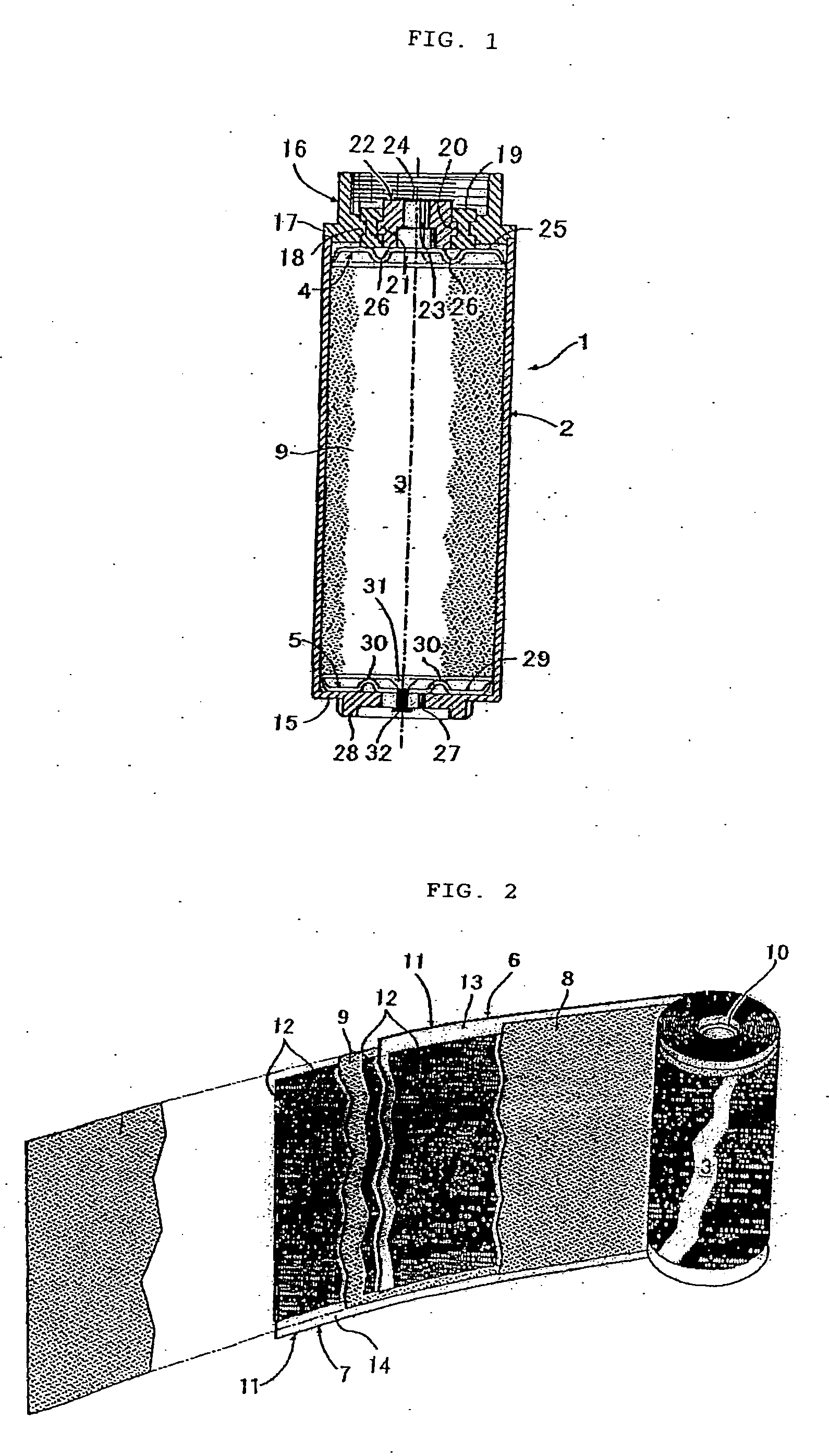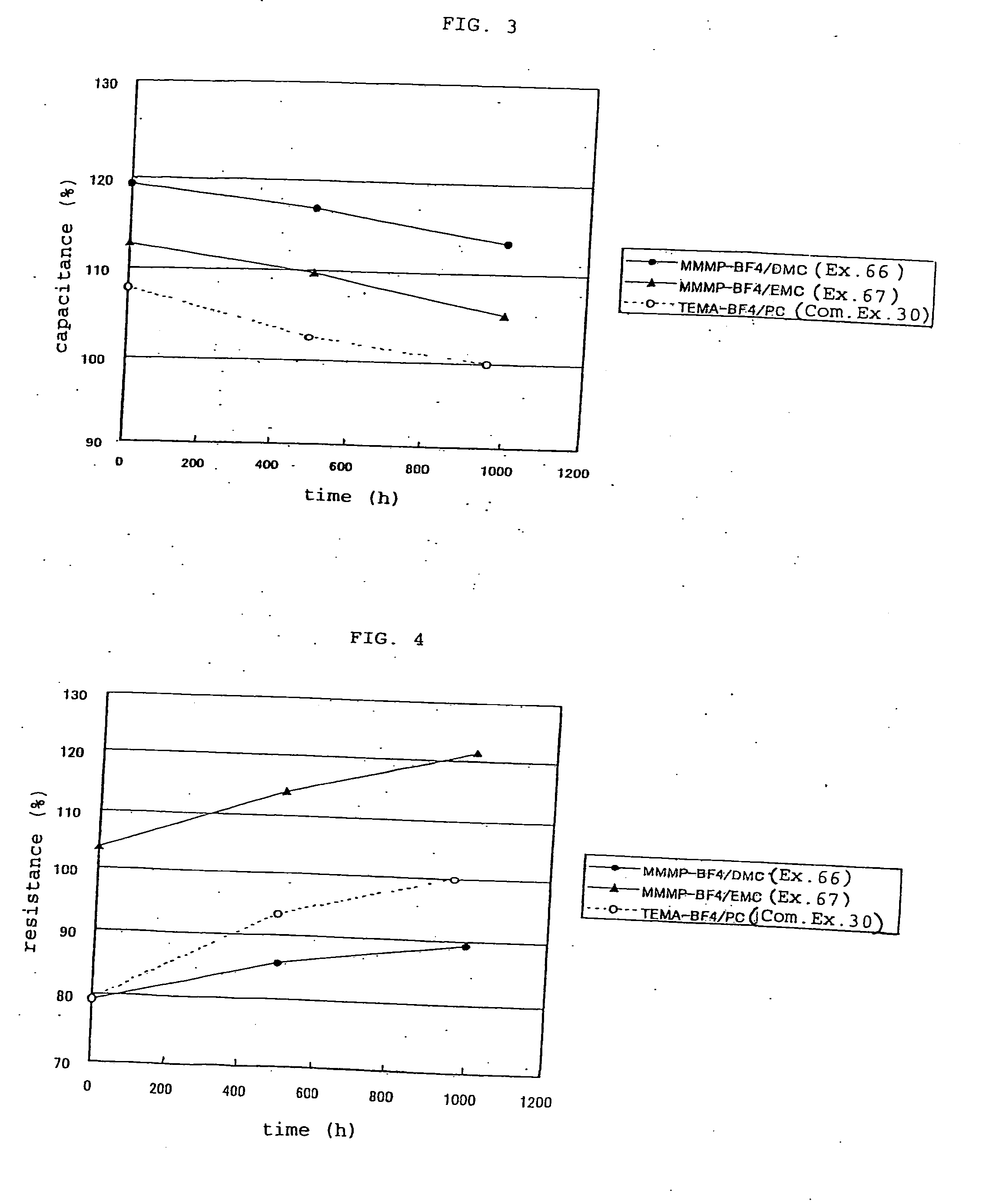Quaternary ammonium salt, electrolyte, and electrochemical device
a technology of ammonium salt and ammonium salt, which is applied in the direction of electrochemical generators, non-aqueous electrolyte cells, transportation and packaging, etc., can solve the problems of salt separation, impairing the electrical conductivity of the solution, and less soluble electrolyte, etc., and achieves high capacity, low cost, and increased surface area
- Summary
- Abstract
- Description
- Claims
- Application Information
AI Technical Summary
Benefits of technology
Problems solved by technology
Method used
Image
Examples
example 1
Preparation of N-methyl-N-methoxymethylpyrrolidinium chloride (N-methoxymethyl-N-methylpyrrolidinium chloride)
[0111] A 30.0 g quantity of N-methylpyrrolidine (reagent, product of Tokyo Kasei Co., Ltd.) was dissolved in 120 g of toluene, followed by replacement with nitrogen. Chloromethyl methyl ether (31.2 g, reagent, product of Tokyo Kasei Co., Ltd.) was added dropwise to the solution at 5° C. over a period of 1 hour. The mixture was stirred at 5° C. for 1 hour, then gradually heated to a higher temperature, and stirred at room temperature for 10 hours to complete the reaction. The reaction mixture was filtered, and the resulting solid product was washed with 150 g of toluene and 150 g of acetone. The washed product was dried in a vacuum to obtain 53.7 g of the desired product (white solid).
[0112]1H-NMR (D2O) δppm: 2.08(br 4H), 2.96(s 3H), 3.31(m 2H), 3.47(m 2H), 3.55(s 3H), 4.50(s 2H)
example 2
Preparation of N-methyl-N-methoxymethylpyrrolidinium tetrafluoroborate (N-methoxymethyl-N-methylpyrrolidinium tetrafluoroborate)
[0113] A 15.0 g quantity of the N-methyl-N-methoxymethylpyrrolidinium chloride (N-methoxymethyl-N-methylpyrrolidinium chloride) prepared in Example 1 was dissolved in 35 g of MeOH, and 27.83 g of methanol solution of 30% HBF4 was added to the solution. Hydrogen chloride and an excess of HBF4 were removed from the mixture in a vacuum to obtain 19.6 g of the desired product (pale yellow liquid).
[0114]1H-NMR (d-DMSO) δppm: 2.07(br 4H), 3.00(s 3H), 3.42(m 4H), 3.60(s 3H), 4.62(s 2H)
example 3
Prepartion of N-methyl-N-methoxymethylpyrrolidinium bistrifluoromethanesulfonylimide (N-methoxymethyl-N-methylpyrrolidinium bistrifluoromethanesulfonylimide)
[0115] A 15.0 g quantity of the N-methyl-N-methoxymethylpyrrolidinium chloride (N-methoxymethyl-N-methylpyrrolidinium chloride) prepared in Example 1 was dissolved in 85 g of water, and 26.9 g of lithium bistrifluoromethanesulfonylimide (reagent, product of Aldrich Corp.) was added to the solution at room temperature. The mixture was stirred for 30 minutes, and chloroform was added to the mixture for extraction. The organic layer was washed with 50 g of water 15 times, thereafter concentrated in a vacuum and dried, giving 33.4 g of the desired product in the form of a colorless liquid.
[0116]1H-NMR (d-DMSO) δppm: 2.08(br 4H), 3.00(s 3H), 3.42(m 4H), 3.59(s 3H), 4.63(s 2H)
PUM
 Login to View More
Login to View More Abstract
Description
Claims
Application Information
 Login to View More
Login to View More - R&D
- Intellectual Property
- Life Sciences
- Materials
- Tech Scout
- Unparalleled Data Quality
- Higher Quality Content
- 60% Fewer Hallucinations
Browse by: Latest US Patents, China's latest patents, Technical Efficacy Thesaurus, Application Domain, Technology Topic, Popular Technical Reports.
© 2025 PatSnap. All rights reserved.Legal|Privacy policy|Modern Slavery Act Transparency Statement|Sitemap|About US| Contact US: help@patsnap.com



